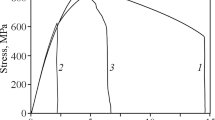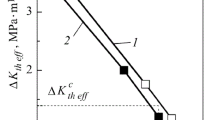Abstract
The macroscopic features of hydrogen-induced static fatigue have been identified. The process is one of crack initiation and slow crack growth, followed by cataclysmic crack propagation (fracture). An electrical resistance method was developed to permit analysis of the crack growth kinetics. Specimens containing a high hydrogen concentration in the surface layers were examined. Three distinct stages of crack growth were identified. The first stage was characteristic of crack growth through a pre-existent hydrogen-rich region (surface layer), while the second stage was associated with the gross inward diffusion of hydrogen. The third stage was associated with imminent fracture.
Similar content being viewed by others
References
E. H. Bucknall, W. Nicholls, and L. H. Toft: Delayed Cracking in Alloy Steel Plates. Symposium on Internal Stresses in Metals and Alloys. Monograph and Report Series No. 5, Institute of Metals, 1948.
W. A. Bell and A. H. Sully: Some Effects of Hydrogen on the Delayed Fracture of High-Tensile Steel. Journal Iron and Steel Institute, 1954, vol. 178, pp. 15–18.
R. P. Frohmberg, W. J. Barnett, and A. R. Troiano: Delayed Failure and Hydrogen Embrittlement in Steel. ASM Trans., 1955, vol. 47, pp. 892–925.
C. L. M. Cottrell: Delayed Brittle Fracture of Alloy Steel at Low Stress Levels. Nature, 1952, vol. 170, pp. 1079–1080.
G. Sachs, J. D. Lubahn, and L. J. Ebert: Notch Bar Tensile Test Characteristics of Heat Treated Low Alloy Steels. ASM Trans., 1944, vol. 33, p. 340
D. Post: Photoelastic Stress Analysis for an Edge Crack in a Tensile Field. Proceedings Soc. for Experimental Stress Analysis, 1954, vol. 3, No. 1, p. 99.
W. Geller and T. Sun: Influence of Alloying Additions Upon Diffusion of Hydrogen in Iron and Contribution to the Iron-Hydrogen System. Archiv für das Eisenhuttenwesen, 1950, vol. 21, p. 423
E. Orowan: Fundamentals of Brittle Behavior in Metals. Fatigue and Fracture of Metals, p. 139. J. Wiley & Sons. New York, 1952.
A. A. Griffith: The Phenomenon of Rupture and Flow in Solids. Philosophical Trans. Royal Soc., 1920, vol. A221, p. 163.
A. A. Griffith: The Theory of Rupture. Proceedings First International Congress of Applied Mechanics, Delft, 1924, p. 55.
A. A. Wells: The Mechanics of Notch Brittle Fracture. Welding Research, London, 1953, vol. 7, No. 2, p. 34r.
L. S. Darken and R. P. Smith: Behavior of Hydrogen in Steel During and After Immersion in Acid. Corrosion, 1948, vol. 5, p. 1
J. H. Andrews and H. Lee: Internal Stresses and Formation of Hair-Line Cracks in Steel. Institute of Metals Symposium on Internal Stresses in Metals and Alloys, 1948, pp. 265–273.
J. H. Keeler and H. M. Davis: The Density and Hydrogen Occlusion of Some Ferrous Metals. AIME Trans., 1953, vol. 197, p. 44; Journal of Metals, January 1953.
W. R. Heller: Hydrogen in Iron and Its Alloys. Stress Corrosion Phenomena. 1956, pp. 163–175. Ed. by W. D. Robertson. New York. John Wiley & Sons.
Author information
Authors and Affiliations
Additional information
TP 4285E. Manuscript, Sept. 15, 1955. New York Meeting, February 1956.
Rights and permissions
About this article
Cite this article
Barnett, W.J., Troiano, A.R. Crack propagation in the hydrogen-induced brittle fracture of steel. JOM 9, 486–494 (1957). https://doi.org/10.1007/BF03397905
Published:
Issue Date:
DOI: https://doi.org/10.1007/BF03397905




